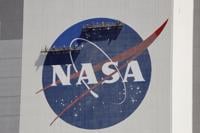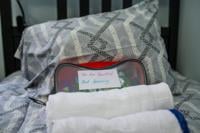A video shared on social media appears to show a ground's-eye view of Mars, claiming that NASA just released the “clearest view of Mars yet” along with “actual sounds” from the red planet. The claim is misleading. The picture does feature a landscape on the fourth rock from the sun, and the audio is plausibly from the same spot. However, the image comes from photos taken by a Mars rover in 2005, not recently.
A Nov. 23 () on TikTok pans across a shot of rugged, reddish terrain peppered with shimmering black rocks, while audio akin to wind or white noise plays overtop. At the bottom, a cut-out video of a young woman presents the scene: “NASA releases stunning footage. Clearest view of Mars yet with actual sounds captured 140 million miles away.”
The same quote was posted alongside the video as well as hashtags including #MarsSelfie and #NASA.
The post had 14.8 million views and 1.3 million likes before it was taken down from the platform.
Rating: Misleading
The post depicts a real place on Mars, but does so with a photo two decades old.
“The images do indeed appear to be from Mars. However, perhaps not the most up to date,” said NASA spokesman David Agle in an email.
He said the shot seems to match a 2005 of Husband Hill in Mars’s Gusev crater. The image, a composite of several shots captured by a panoramic camera, was taken by NASA’s Spirit rover the year after it landed at the 166-kilometre-wide bowl.
A search of NASA’s image database shows that the picture, taken during a “descent from the summit of Husband Hill,” was on Dec. 14, 2005.
Real presenter footage, fake voice
The visual clip of a woman appearing to speak at the bottom of the screen is actually cut and pasted from a social media video posted by life coach Amy Wang. With YouTube notching more than 584,000 subscribers combined, Wang posts videos on topics ranging from study tips to self-development and “productivity hacks.”
A reverse image search found that the video is clipped wholesale from a Nov. 11 post on how “to be successful AND live a good life.” The 10-second clip begins , with the gestures and clothing identical to those of the shot pasted into the TikTok post about Mars.
At first listen, the voice sounds similar to Wang’s own. But the words — describing “stunning footage” and “actual sounds” from the extraterrestrial planet — are totally different from those in her own video: “And so, just like with a math problem — you know, math was my best subject, my favourite subject — and whenever I do math I’m very precise….”
The lip movement also doesn’t align perfectly with the words spoken, and appears to have been digitally manipulated. The audio was likely generated via an artificial intelligence program that can hoover up clips and then spit out a passable impersonation of the speaker’s voice.
���ϳԹ��� ran the video through deepfake detector , which found the post lacks "natural flow" and shows "substantial evidence of manipulation."
Deepfakes are still images, audio and video that have been manipulated or wholly created by artificial intelligence (AI) tools.
Deepfake detectors cannot always be relied on. But a human source lent even more weight to the finding.
"It's creepy and concerning," said Wang in an email, confirming she never said the words uttered in the TikTok post.
The digital creator and podcaster learned of it on Nov. 23 after friends and followers began to message her.
She said viewers of short-form online videos often don't take the time to examine content or "look closely at the AI lips and chin" to discern reality from falsehood.
"I'm relieved that at least the AI deepfake is rather neutral and just talking about things like Mars. However, it's scary that this means anyone can use technology to make anyone say whatever they want. They can easily warp the truth and reality," Wang said.
While the original TikTok post has been removed from the platform, the account is still using Wang's likeness and voice on other videos featuring shots supposedly from Mars.
Windy world
The post's atmospheric sounds, reminiscent of windswept plains in an old western, sound the same as on NASA's website. An analysis of the waveforms suggests the audio is identical, with the clip simply on a loop in the TikTok post.
Deploying its Perseverance rover, the space agency first made recordings of wind and other sounds on Mars in February 2021 — 16 years after the image posted on TikTok was captured by the Spirit rover, but still more than three years ago. So presenting the audio as having just been made — and been made in tandem with the photo — is misleading. Moreover, the recordings were taped at the Jezero crater rather than Gusev crater, which sits on another part of the planet. NASA did not confirm whether the audio was authentic.
Mistaken identity
Several commenters on the viral TikTok post said the image came from Devon Island in Nunavut. Sitting directly south of Ellesmere Island in Canada's High Arctic, the world’s largest uninhabited island plays host to NASA training exercises and a research station that overlooks the Haughton Crater. The site features barren terrain, freezing temperatures and other Mars-like characteristics.
“This harsh climate mimics the environmental conditions on Mars and other planets,” the agency on a web page about the Haughton Mars Project, led by NASA’s Ames Research Center.
However, NASA confirmed that the TikTok post featured not a faux Martian landscape, but the real deal.
Sources
TikTok post has been ()
()
()
()
()
()
()
()
()
About ���ϳԹ��� Press fact checks
You can find out more about ���ϳԹ��� here and about ���ϳԹ��� Press Fact Checks here. To reach our fact-checking team with any tips, corrections or comments, please email us at cpfactcheck@thecanadianpress.com.
Note to readers: This story was updated on Dec. 17, 2024, to correct the spelling of "claiming" in the headline.






































